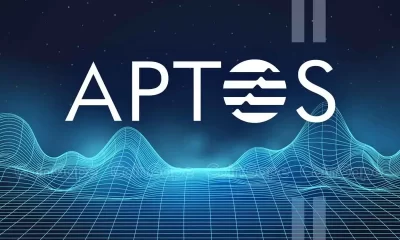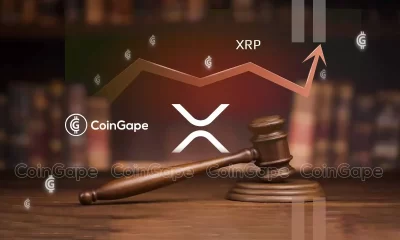Finance
Galaxy Digital Gets SEC Nod for U.S. Listing, Eyes Nasdaq Debut in May
Published
1 week agoon
By
admin

Galaxy Digital is moving closer to a U.S. stock market listing after the Securities and Exchange Commission (SEC) approved its registration statement tied to a corporate reorganization.
The crypto and AI infrastructure firm, currently listed in the Toronto Stock Exchange, aims to shift its home base from the Cayman Islands to Delaware and list shares on the Nasdaq as “GLXY.” The firm’s expansion into the U.S. market comes as institutional demand for regulated crypto products continues to grow.
The company has scheduled a shareholder vote on the reorganization for May 9. The firm is expected to list shortly afterward. CEO Mike Novogratz called the registration effectiveness “an important milestone” in the firm’s bid to expand its reach.
Galaxy provides institutional services in crypto trading, asset management, and tokenization. It also invests in and operates data centers that power AI and high-performance computing.
Disclaimer: Parts of this article were generated with the assistance from AI tools and reviewed by our editorial team to ensure accuracy and adherence to our standards. For more information, see CoinDesk’s full AI Policy.
Source link
You may like


Apple Delists 14 Crypto Apps in South Korea Including KuCoin and MEXC Exchanges Amid Regulatory Crackdown


Athens Exchange Group eyes first onchain order book via Sui


Futureverse Acquires Candy Digital, Taps DC Comics and Netflix IP to Boost Metaverse Strategy


Court Grants Ripple And SEC’s Joint Motion To Suspend Appeal


AVAX Falls 2.1% as Nearly All Assets Trade Lower


What is a VTuber, and how do you become one in 2025?
FastNews
Tokenization Firm Securitize Acquires MG Stover’s Digital Asset Fund Administration Unit
Published
20 hours agoon
April 15, 2025By
admin

Securitize, one of the largest tokenized asset issuers, said on Tuesday it has acquired MG Stover’s fund administration business, making its subsidiary Securitize Fund Services the largest digital asset fund administrator.
MG Stover’s team will now operate under Securitize Fund Services (SFS), enhancing the company’s institutional-grade offerings, the company said in a press release.
With the acquisition, SFS now oversees $38 billion of assets under administration across 715 funds, including Securitize’s tokenized fund offerings such as BlackRock’s $2.45 billion tokenized U.S. Treasury fund (BUIDL). Securitize now offers an integrated suite of services: fund administration, token issuance, brokerage, transfer agency, and an alternative trading system (ATS).
The deal signals growing consolidation in the digital asset infrastructure space, where companies are racing to build compliant platforms that mirror traditional finance but live on blockchain rails. For asset managers, this means they can issue tokenized securities, administer them, and trade them—without leaving the ecosystem.
Carlos Domingo, co-founder and CEO of Securitize, said that the acquisition “cements our role as the most comprehensive platform for institutional grade real-world asset tokenization and fund administration.”
Asset tokenization is perhaps the fastest growing digital asset sector, as global traditional finance firms and banks increasingly use blockchains for moving and managing instruments like funds, bonds and credit. BCG and Ripple projected the tokenized asset market to reach $18 trillion by 2033. However, the rapid growth also comes with risks, including operational inexperience, according to a Moody’s report.
Read more: Tokenized Funds’ Rapid Growth Comes With Red Flags: Moody’s
Source link
artificial intelligence
Where Top VCs Think Crypto x AI Is Headed Next
Published
3 days agoon
April 13, 2025By
admin

The proliferation of mainstream artificial intelligence (AI) tools in the last couple of years has stirred the crypto and blockchain industry to explore decentralized alternatives to Big Tech products.
The synergy between AI and blockchain is built on addressing the risk of centralized ownership and access to data that powers AI. The theory goes that decentralization can mitigate against the entire AI economy being powered by the data owned by a few tech behemoths like Alphabet (GOOG), Amazon (AMZN), Microsoft (MSFT), Alibaba (9988) and Tencent (0700).
It is unclear as yet whether or not this will prove to be a significant problem at all, much less whether the blockchain industry will be able to solve it. What is clear, however, is that crypto venture capitalists (VCs) are willing to spend millions of dollars finding out. Decentralized AI has thus far attracted $917 million in VC and private equity money, according to startup deal platform Tracxn.
The question remains whether the trend of investing in blockchain-based AI is still built on hype or has now transcended to being the real deal.
Blockchain investment company Theta Capital described AI x crypto as “the inevitable backbone of AI,” in a recent “Satellite View” report, which explored insights and outlooks from the sector’s prominent investors.
AI agents
“No trend stands out more than the intersection of AI and crypto,” the report said, using the examples of AI agents trading on blockchains and even launching tokens.
This may appear to be a more sophisticated form of speculation for degens, but Theta argues it’s a route to tackling some of AI’s problems that only crypto can solve.
“Crypto wallets enable the participation of autonomous agents in financial markets,” according to the report. “Decentralized token networks are bootstrapping the supply side of key AI infrastructure for compute, data and energy.”
The report’s conclusion is far from being hype and speculation; AI x crypto is “the new meta.” Meta is short for “metagame,” a term borrowed from gaming referring to the dominant way of playing with regard to characters, strategies or moves based on the competitive landscape.
Decentralized AI
Alex Pack, managing partner of blockchain venture capital firm Hack VC, described Web3 AI as “the biggest source of alpha in investing today,” in the “Satellite View” report.
Hack VC has dedicated 41% of its latest fund to Web3 AI, according to the report, in which it sees the main challenge as building a decentralized alternative to the AI economy.
“AI’s rapid evolution is creating massive efficiencies, but also increasing centralization,” Pack said.
“The intersection of crypto and AI is by far the biggest investment opportunity in the space, offering an open, decentralized alternative.”
One of Hack VC’s most prominent portfolio companies is Grass, which encourages users to participate in AI networks by offering up their unused internet bandwidth in return for tokens.
This is designed as an alternative to large firms installing software code into apps in order to scrape their users’ data.
“Users unwittingly donate their bandwidth without compensation,” Grass founder Andrej Radonjic said in Theta’s report.
“Grass provides an alternative [by] forming a massive opt-in, peer-to-peer network able to produce high-quality data at the scale of Google and Microsoft.”
The dreaded AI “takeover”
Decentralized AI presents risks for investors, Theta concedes. It could lead to the proliferation of all the least desirable facets of the internet as it already exists: putrid online discourse, spam emails or vapid social media content in the form of blogs, videos or memes. In the crypto world, an example of this may be the creation of meme tokens. The questionable endorsements, the wash trading and the pump and dumps can all be handled by AI engines even more efficiently than humans.
Some VCs see blockchain as the basis for mitigation. Olaf Carlson-Wee, CEO and founder of Polychain, provided the examples of proof-of-humanity mechanisms to verify that users are human and disincentivizing spam through micropayments or spam.
“If sending an email costs $0.01, it would destroy the economics of spam while remaining affordable for average users,” he said in the report.
With blockchain possibly providing some of these safeguards, Carlson-Wee believes AI will underpin digital and financial systems, as they could outperform humans in markets. This reality, he claims, would be gladly accepted, as opposed to dreaded as some sort of bleak dystopia.
“Over time, AI systems will evolve into long-term capital allocators, predicting trends and opportunities years into the future, [which] humans will entrust their funds to, because of the superior ability to make data-driven decisions,” Carlson-Wee said.
“The AI takeover won’t be a war we lose – it will be a suggestion we agree to,” he concluded.
Source link
Bitcoin mining
Luxor’s Aaron Foster on Bitcoin Mining’s Growing Sophistication
Published
4 days agoon
April 12, 2025By
admin

Luxor Technology wants to make bitcoin mining easier. That’s why the firm has rolled out a panoply of products (mining pools, hashrate derivatives, data analytics, ASIC brokerage) to help bitcoin miners, large and small, develop their operations.
Aaron Forster, the company’s director of business development, joined in October 2021, and has seen the team grow from roughly 15 to 85 people in the span of three and a half years.
Forster worked a decade in the Canadian energy sector before coming to bitcoin mining, which is one of the reasons why he’ll be speaking about the future of mining in Canada and the U.S. at the BTC & Mining Summit at Consensus this year.
Follow full coverage of Consensus 2025 in Toronto May 14-16.
In the leadup to the event, Forster shared with CoinDesk his thoughts on bitcoin miners turning to artificial intelligence, the growing sophistication of the mining industry, and how Luxor’s products enable miners to hedge various forms of risk.
This interview has been condensed and edited for clarity.
CoinDesk: Mining pools allow miners to combine their computational resources to have higher chances of receiving bitcoin block rewards. Can you explain to us how Luxor’s mining pools work?
Aaron Forster: Mining pools are basically aggregators that reduce the variance of solo mining. When you look at solo mining, it’s very lottery-esque, meaning that you could be plugging your machines in and you might hit block rewards tomorrow — or you might hit it 100 years from now. But you’re still paying for energy during that time. At a small scale, it’s not a big deal, as you scale that up and create a business around it.
The most common kind of mining pool is PPLNS, which means Pay-Per-Last-N-Shares. Basically, that means the miner does not get paid unless that mining pool hits the block. That’s also due to luck variance, so it’s no different from that solo miner’s situation. However, that creates revenue volatility for those large industrial miners.
So we’re seeing the emergence of what we call Full-Pay-Per-Share, or FPPS, and that’s Luxor is operating for our bitcoin pool. With FPPS, regardless of whether we find a block or not, we’re still paying our miners their revenue based on the number of shares they’ve submitted to the pool. That gives revenue certainty to miners, assuming hashprice stays the same. We’ve effectively become an insurance provider.
The problem is that you need a very deep and strong balance sheet to support that model, because while we’ve reduced the variance for miners, that risk is now put on us. So we need to plan for that. But it can be calculated over a long enough period of time. We have different partners in that regard, so that we don’t bear the full risk from our balance sheet.
Tell me about your ASIC brokerage business.
We’ve become one of the leading hardware suppliers on the secondary market. Primarily within North America, but we’ve shipped to 35+ countries. We deal with everybody from public companies to private companies, institutions to retail.
We’re primarily a broker, meaning we match buyer and seller, mostly on the secondary market. Sometimes we do interact with ASIC manufacturers, and in certain cases we do take principal positions, meaning we use money from our balance sheet to purchase ASICs and then resell them on the secondary market. But the majority of our volume comes from matching buyers and sellers.
Luxor also launched the first hashrate futures contracts.
We’re trying to push the Bitcoin mining space forward. We’re a hashrate marketplace, depending on how you look at our mining pools, and we wanted to take a big leap and take hashrate to the TradFi world.
We wanted to create a tool that allows investors to take a position on hashprice without effectively owning mining equipment. Hashprice is, you know, the hourly or daily revenue that miners get, and that fluctuates a lot. For some people it’s about hedging, for others it’s speculation. We’re creating a tool for miners to sell their hashrate forward and use it as a basic collateral or a way to finance growth.
We said, ‘Let’s allow miners to basically sell forward hashrate, receive bitcoin upfront, and then they can take that and do whatever they need to do with it, whether it’s purchase ASICs or expand their mining operations.’ It’s basically the collateralization of hashrate. So they’re obligated to send us X amount of hashrate per month for the length of the contract. Before that, they’ll receive a certain amount of bitcoin upfront.
There’s a market imbalance between buyers and sellers. We have a lot of buyers, meaning people and institutions wanting to earn yield on their bitcoin. What you’re lending your bitcoin at is effectively your interest rate. However, you could also look at it like you’re purchasing that hashrate at a discount. That’s important for institutions or folks that don’t want physical exposure to bitcoin mining, but want exposure to hash price or hashrate. They can do that synthetically through purchasing bitcoin and putting it into our market, effectively lending that out, earning a yield, and purchasing that hashrate at a discount.
What do you find most exciting about bitcoin mining at the moment?
The acceptance and natural progression of our industry into other markets. We can’t ignore the AI HPC transition. Instead of building these mega mines that are just massive buildings with power-dense bitcoin mining operations, you’re starting to see large miners turning into power infrastructure providers for artificial intelligence.
Using bitcoin mining as a stepping stone to a larger, more capital intensive industry like AI is exciting to me, because it kind of gives us a bit more acceptance, because we’re coming at it from a completely different angle. I think the biggest example is the Core Scientific / CoreWeave deal structure, how they’ve kind of merged those two businesses together. They’re complimentary to each other. And that’s really exciting.
When you look at our own product roadmap, we have no choice but to follow a similar roadmap to bitcoin miners. A lot of the products that we built for the mining industry are analogous to what is needed at a different level for AI. Mind you, it’s a lot simpler in our industry than in AI. We’re our first step into the HPC space, and it’s still very early days there.
Source link

Apple Delists 14 Crypto Apps in South Korea Including KuCoin and MEXC Exchanges Amid Regulatory Crackdown

Athens Exchange Group eyes first onchain order book via Sui

Futureverse Acquires Candy Digital, Taps DC Comics and Netflix IP to Boost Metaverse Strategy
Court Grants Ripple And SEC’s Joint Motion To Suspend Appeal

AVAX Falls 2.1% as Nearly All Assets Trade Lower

What is a VTuber, and how do you become one in 2025?

Top Expert’s Update Sets $10 Target

How Academia Interacts With The Bitcoin Ecosystem

AB DAO and Bitget Launch Dual Reward Campaign, Distributing $2.6M Worth of $AB Globally

AI crypto tokens at risk as Nvidia faces restrictions on China exports

Coinbase Urges Australia to Vote for Crypto Progress in May

How High Would Pi Network Price Go If Pi Coin Adopts Transparency to Avoid Mantra Pitfalls

XRP’s ‘Rising Wedge’ Breakdown Puts Focus on $1.6 Price Support

China selling seized crypto to top up coffers as economy slows: Report

Ethereum Price Dips Again—Time to Panic or Opportunity to Buy?

Arthur Hayes, Murad’s Prediction For Meme Coins, AI & DeFi Coins For 2025

Expert Sees Bitcoin Dipping To $50K While Bullish Signs Persist

Aptos Leverages Chainlink To Enhance Scalability and Data Access

Bitcoin Could Rally to $80,000 on the Eve of US Elections

Crypto’s Big Trump Gamble Is Risky

Sonic Now ‘Golden Standard’ of Layer-2s After Scaling Transactions to 16,000+ per Second, Says Andre Cronje

Institutional Investors Go All In on Crypto as 57% Plan to Boost Allocations as Bull Run Heats Up, Sygnum Survey Reveals

Ripple-SEC Case Ends, But These 3 Rivals Could Jump 500x

3 Voting Polls Show Why Ripple’s XRP Price Could Hit $10 Soon

Has The Bitcoin Price Already Peaked?

A16z-backed Espresso announces mainnet launch of core product

The Future of Bitcoin: Scaling, Institutional Adoption, and Strategic Reserves with Rich Rines

Xmas Altcoin Rally Insights by BNM Agent I

Blockchain groups challenge new broker reporting rule

I’m Grateful for Trump’s Embrace of Bitcoin
Trending

 24/7 Cryptocurrency News5 months ago
24/7 Cryptocurrency News5 months agoArthur Hayes, Murad’s Prediction For Meme Coins, AI & DeFi Coins For 2025

 Bitcoin3 months ago
Bitcoin3 months agoExpert Sees Bitcoin Dipping To $50K While Bullish Signs Persist

 24/7 Cryptocurrency News3 months ago
24/7 Cryptocurrency News3 months agoAptos Leverages Chainlink To Enhance Scalability and Data Access

 Bitcoin5 months ago
Bitcoin5 months agoBitcoin Could Rally to $80,000 on the Eve of US Elections

 Opinion5 months ago
Opinion5 months agoCrypto’s Big Trump Gamble Is Risky

 Altcoins3 months ago
Altcoins3 months agoSonic Now ‘Golden Standard’ of Layer-2s After Scaling Transactions to 16,000+ per Second, Says Andre Cronje

 Bitcoin5 months ago
Bitcoin5 months agoInstitutional Investors Go All In on Crypto as 57% Plan to Boost Allocations as Bull Run Heats Up, Sygnum Survey Reveals

 Price analysis5 months ago
Price analysis5 months agoRipple-SEC Case Ends, But These 3 Rivals Could Jump 500x


